When Eric Hertz, founder of Earth River Expeditions, focused his conservation efforts on stopping the James Bay Hydro-electric Project in Quebec, he experienced “the same frustration [he] felt 15 years earlier during [his] WISE project.”
During his senior year at Woodlands High School in 1973, Eric and his friend Danny Zwerner uncovered the mystery of the purple Toms River in New Jersey. After canoeing down the river, they not only discovered that a toxic dye was being dumped into it, but also that water pollution was “perfectly legal” at the time.
Eric’s WISE project was a stepping stone to his career in global environmental conservation. Since WISE, Eric has taken an active role in preserving and bringing awareness to threatened 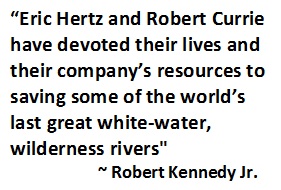 rivers. Some of his main accomplishments include creating the Earth River Land Trust on the Futaleufu, which has protected over 20 kilometers of the river’s shoreline, and founding Earth River Expeditions, a company that specializes in wilderness expeditions and rafting trips down Patagonia’s Futaleufu River, with his partner Robert Currie.
rivers. Some of his main accomplishments include creating the Earth River Land Trust on the Futaleufu, which has protected over 20 kilometers of the river’s shoreline, and founding Earth River Expeditions, a company that specializes in wilderness expeditions and rafting trips down Patagonia’s Futaleufu River, with his partner Robert Currie.
Eric’s WISE story is featured below.
School Struggles
In the final week of first grade, Mrs. Lipps announced to the class that she was going to 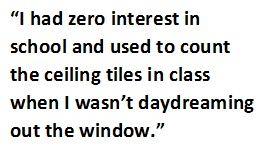 leave someone back and named me as one of the three most likely suspects. Getting left back was like being sent to purgatory. Getting left back at 7 was hell. I somehow managed to make the cut into second grade, but my parents were called in on numerous occasions to discuss my slow progress and limited mental capacity. There was no left brain and right brain in 1962, just dumb and dumber.
leave someone back and named me as one of the three most likely suspects. Getting left back was like being sent to purgatory. Getting left back at 7 was hell. I somehow managed to make the cut into second grade, but my parents were called in on numerous occasions to discuss my slow progress and limited mental capacity. There was no left brain and right brain in 1962, just dumb and dumber.
In the third grade, the principal called the parents in to discuss the results of my achievement test. I had scored in the top 98 percentile in math and English. From that point on, as I continued to struggle, my parents, especially my mom, thought I was a brilliant underachiever. I had zero interest in school and used to count the ceiling tiles in class when I wasn’t daydreaming out the window. It wasn’t until my mother was in her sixties and telling some friends my achievement test story for the umpteenth time that I came clean and told her I cheated off Nancy Kidwell, the girl with red hair that everyone teased.
While I was fighting not to be left back in school on numerous occasions, my father had skipped multiple grades. He attended Williams College at 16. Now he was an accountant. To call my dad a workaholic would be an understatement. He commuted into the city first thing in the morning dressed in a suit, tie, and a Humphrey Bogart style hat. He returned home late in the evening long after I was asleep. Although my mother had long ago talked my father out of me someday joining his firm, he still had high hopes of me attending his Alma mater. But my chances of getting in to Williams were worse than the Dodgers coming back to Brooklyn.
 In the twelfth grade, I walked into the office of the Dean of Admissions at Williams College, and before I even sat down he said, “Eric, I know you’re probably a very nice young man, and I hear from your father, a very fine wrestler. But I’m going to be frank with you, son. I really don’t think you have the intellectual capacity to survive at Williams. Now I don’t want you to take this wrong. I’m sure there’s a fine wrestling school you would do great at.”
In the twelfth grade, I walked into the office of the Dean of Admissions at Williams College, and before I even sat down he said, “Eric, I know you’re probably a very nice young man, and I hear from your father, a very fine wrestler. But I’m going to be frank with you, son. I really don’t think you have the intellectual capacity to survive at Williams. Now I don’t want you to take this wrong. I’m sure there’s a fine wrestling school you would do great at.”
I got into Hobart College, and it had nothing to do with grades, SATS or wrestling but rather an hour long admissions interview spent entirely on my WISE project and two month long, cross country, bicycle trip I took in the summer of my sophomore year.
Finding and Pursuing a Passion
I loved the outdoors—streams, rivers, lakes—and would spend my free time at a tiny brook in the woods behind our house. At 8, I managed to follow the stream five miles to the Sprain Brook Reservoir in Yonkers. After a search, the police found me, and I was delivered back home.
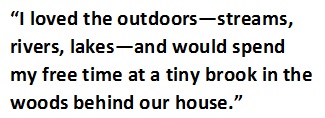 I don’t think my dad had ever been in the woods before. His definition of the woods was a golf course. My definition of the golf course was a clear-cut woods.
I don’t think my dad had ever been in the woods before. His definition of the woods was a golf course. My definition of the golf course was a clear-cut woods.
My mother thought it would be a good idea for my father and me to do some things together, and she came up with a compromise. Some weekends I would swing clubs at a frustrating little white ball with my dad and on others he would take me camping on whitewater canoeing trips. This was a far bigger compromise for my father. He hated setting up the tent, sleeping on the ground, and having no bathroom; he was also terrified of rapids.
 We joined the local chapter of the Sierra Club, not because my dad ever thought about the environment, but because they organized weekend canoe trips to nearby rivers like the Delaware and Housatonic. He was a devout libertarian of the Ludweig Von Mises, Austrian School and thought that Malthus was a crackpot for believing there could ever be a scarcity of resources like air and water. As kids, my sisters and I learned not to bring up environmental problems less we get a lecture on how the free market and technology could solve them.
We joined the local chapter of the Sierra Club, not because my dad ever thought about the environment, but because they organized weekend canoe trips to nearby rivers like the Delaware and Housatonic. He was a devout libertarian of the Ludweig Von Mises, Austrian School and thought that Malthus was a crackpot for believing there could ever be a scarcity of resources like air and water. As kids, my sisters and I learned not to bring up environmental problems less we get a lecture on how the free market and technology could solve them.
The “Aha” Moment
That first canoe trip with my dad had quite an impact on me. We were running the Toms River in New Jersey through the Pine Barrens. The rapids were more like riffles, but at 9, they felt like tidal waves. I could barely contain my excitement. Maneuvering the canoe through the swift bends was the best feeling I had ever had and closest I had ever been to my dad. Seeing my joy, he almost relaxed and even hinted that we might be able to do it again.
Towards the end of the first day, we rounded a bend and passed a giant pipe entering the river through the forest. Suddenly the river went from clear to purple. I didn’t expect the libertarian, Sierra Club member in the back of my canoe to say anything, but no one else mentioned it either. To be fair, the environmental movement was still in its infancy and litter was still in. But that pipe became my enemy.
On subsequent canoe trips, I saw chemicals or raw sewage being flushed into the White River in Vermont and the Housatonic in Connecticut. All through my school years I don’t ever remember an adult speaking about environmental issues.
An Environmental WISE Project: Conserving the Toms River
When Vic Leviatin and Andy Courtney came up with the WISE program in Woodlands High School, my good friend Danny Zwerner and I decided to do it together. Danny was ranked at the top of our class, headed to Hamilton College and destined to be a doctor or a lawyer. I was a wrestler ranked in the lower half of my class and destined to be anything but an accountant. Vic, Andy and the other creators of this new senior class experiment therefore fully expected my friend Danny to help motivate me with our project—and I couldn’t blame them.
But for the first time in school I was excited about something. I could get academic credit for something other than daydreaming and counting ceiling tiles; I could go canoeing and take pictures.
I had always wondered what the purple chemical coming from the pipe on the 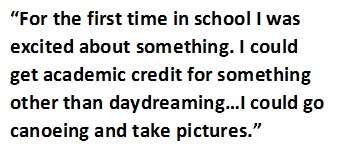 Toms River was. So for our WISE project, Danny and I would paddle down the Toms River to the pipe, document the purple coming into the river, and trace it back to its source. Samples would be collected of the purple liquid as well as river samples above and below the pipe. They would be sent out to a laboratory to be tested. If we could prove they were contaminating the river, we would attempt to alert the appropriate authorities.
Toms River was. So for our WISE project, Danny and I would paddle down the Toms River to the pipe, document the purple coming into the river, and trace it back to its source. Samples would be collected of the purple liquid as well as river samples above and below the pipe. They would be sent out to a laboratory to be tested. If we could prove they were contaminating the river, we would attempt to alert the appropriate authorities.
All the time spent with my father had finally paid off, as I had gained the necessary river experience to take Danny down a river I hadn’t seen in ten years. We loaded my dad’s aluminum canoe on the car and drove to southern New Jersey. The rapids were much smaller than I remembered, but the pipe hadn’t changed. It had been spewing the same 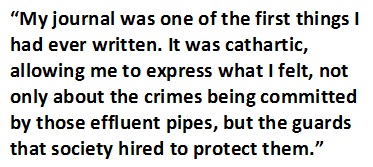 purple chemical all these years. We followed the color to a tall, chain-link fence plastered with no trespassing signs and topped with barbwire. Once over the fence, the pipe led us to a lagoon filled with purple dye. As we were taking a sample, a security guard saw us and yelled, “Hey, what are you kids doing?” and stared running towards us. We grabbed the sample and took off. In pursuit, he yelled “Stop!” but thankfully never said, “or I’ll shoot!” We reached the fence, scrambled over it, and took off downstream in our own version of Deliverance.
purple chemical all these years. We followed the color to a tall, chain-link fence plastered with no trespassing signs and topped with barbwire. Once over the fence, the pipe led us to a lagoon filled with purple dye. As we were taking a sample, a security guard saw us and yelled, “Hey, what are you kids doing?” and stared running towards us. We grabbed the sample and took off. In pursuit, he yelled “Stop!” but thankfully never said, “or I’ll shoot!” We reached the fence, scrambled over it, and took off downstream in our own version of Deliverance.
We gathered our evidence, sent it out to be tested, and proved they were polluting the river. We also found out it was perfectly legal for them to be doing so.
A Future of Global Environmental Conservation
Fifteen years later I was working with members of the Cree First Nation to stop a massive hydro-electric project in James Bay, Quebec. If built, eleven major rivers would be dammed, diked, or dewatered. This would flood an area the size of France, polluting the water with mercury and destroying the Cree way of life.
For three summers, beginning in 1991, my company, Earth River Expeditions, had been running conservation awareness rafting trips with the Cree, taking politicians, conservation groups, and media down the threatened Great Whale River. By 1993 we were beginning to gain traction when National Geographic came on a trip and then wrote a scathing article condemning the James Bay project. The New York Times followed with another blistering piece and public opinion in New York also began to turn against it. The power company, Hydro-Quebec, was not pleased.
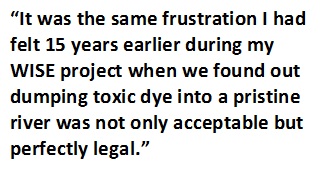 We had also been running commercial expeditions to subsidize the environmental work. In the summer of 1994 we were flying in for our first commercial trip of the season. From the float plane you could see the entire stretch of river we had been running was blackened, scorched to a crisp. Earlier that spring the Cree had seen some strange black smoke coming from their traditional hunting land eighty miles up river. They said no forest fire had ever burned that time of year when there was still snow on the ground. When we landed, one of the guests, a Vietnam veteran, confirmed the area along the river had been napalmed.
We had also been running commercial expeditions to subsidize the environmental work. In the summer of 1994 we were flying in for our first commercial trip of the season. From the float plane you could see the entire stretch of river we had been running was blackened, scorched to a crisp. Earlier that spring the Cree had seen some strange black smoke coming from their traditional hunting land eighty miles up river. They said no forest fire had ever burned that time of year when there was still snow on the ground. When we landed, one of the guests, a Vietnam veteran, confirmed the area along the river had been napalmed.
The charred landscape was eerily quiet. Even the black flies were gone. We were covered in soot from brushing up against the trees. I was seething inside. It was the same frustration I had felt fifteen years earlier during my WISE project when we found out dumping toxic dye into a pristine river was not only acceptable but perfectly legal.
We had constructed a teepee from some partially burned poles. I remember going inside and seeing one of the Cree elders, Jimmy George, cooking some caribou over the fire. His calm demeanor was bewildering. I said, “Jimmy, how can you not be angry about this?” He seemed so passive, and I just wanted to shake him. Without looking up, in a serene tone he replied, “Eric, the Cree have a saying: One bad lucks makes two good lucks. We will find a better stretch of river and stop their project.” His words were prophetic. We found a better stretch of river up stream, and in 1995 New York pulled out of the James Bay project, which killed it.
The Cree also believe in circles, and I can now see how that Cree saying related to my WISE project. Having no way to shut off that toxic pipe was my bad luck. But the success of our WISE project and the others that followed helped WISE prosper so that thirty-seven years later I found myself proudly sitting at my son Cade’s WISE presentation and subsequently at my younger son Teal’s as well as at the presentations of my nieces, Emilia and Isabel. The helplessness and frustration over that pipe also led me down a career path that didn’t require a suit, a tie, and a Humphrey Bogart style hat.
~ Eric Hertz, 1973 WISE Alumnus

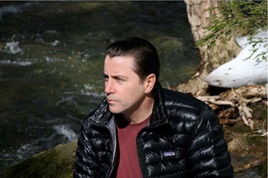
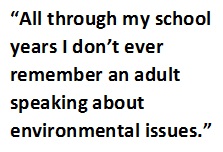
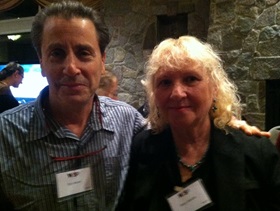
 Saving...
Saving...